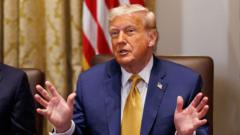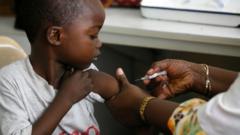While some parents and experts support the proposed legislation, others express skepticism about its implications and feasibility, pointing to challenges regarding enforcement and children's digital freedoms.
**Australia's Ambitious Plan to Ban Kids from Social Media: Will It Succeed?**

**Australia's Ambitious Plan to Ban Kids from Social Media: Will It Succeed?**
The Australian government seeks to implement a bold ban on social media access for children under 16, sparking a heated debate over its potential effectiveness.
As Australia embarks on a groundbreaking initiative, Prime Minister Anthony Albanese has announced plans to prohibit access to social media for children under 16, positioning this legislation as a pioneering effort to safeguard youth. The decision comes in response to alarming incidents of cyberbullying, as illustrated by the experience of a 12-year-old boy—a pseudonym "James"—who faced threats through Snapchat, ultimately prompting his mother to advocate for stricter regulations.
Albanese described the proposed ban, targeting platforms such as X, TikTok, Facebook, and Instagram, as a means to protect children from the "harms" associated with social media, emphasizing the need for childhood free from digital stressors. However, the detailing of implementation remains vague, placing the responsibility on the eSafety Commissioner to establish a comprehensive enforcement strategy.
While many parents endorse the ban, experts warn it may push youths toward unregulated areas of the internet. Digital Industry Group Inc, which represents technology companies, criticized the policy as antiquated, emphasizing the importance of understanding the broader context of social media and suggesting that restricting access may inadvertently create new risks.
eSafety Commissioner Julie Inman Grant acknowledged the daunting challenge of regulating social media, questioning the connection between social media use and mental health decline, especially for vulnerable groups. The balance between protecting children and preserving their online identities remains a complex issue, as demonstrated by 15-year-old Lucas Lane, whose entrepreneurial journey relies on social media interaction.
Over a hundred academics have labeled the ban as an overly simplistic solution without adequate consideration of its implications, as it contradicts UN guidance advocating for safe online access for youth. Critics also highlight other countries’ attempts to legislate similar bans, noting their shortcomings; France and South Korea faced numerous obstacles, such as public backlash and evasion tactics by youth.
Parents advocating for the ban, like Emma, argue that children should spend less time online, fostering in-person interactions instead. Meanwhile, education experts call for a combination of strategies, including digital literacy. Despite the efforts and substantial government funding for educational tools, many young Australians reportedly lack access to regular lessons on safe online behavior.
Looking ahead, the Australian government aims to implement age-verification trials. However, the efficacy of such measures and concerns about privacy loom large, with some experts skeptical about current technology's ability to execute age verification securely.
As the proposed legislation heads to parliament, potential legal challenges and the unpredictability of technology raise doubts about its long-term success. While Prime Minister Albanese acknowledges the limitations of the proposal, the ban symbolizes an effort to provide parents respite from the pressures of an increasingly digital world, even as critics continue to voice their concern over potential unintended consequences. In the eyes of advocates like Emma, the ultimate goal remains clear: to allow children the freedom to grow and thrive away from the digital realm.
Albanese described the proposed ban, targeting platforms such as X, TikTok, Facebook, and Instagram, as a means to protect children from the "harms" associated with social media, emphasizing the need for childhood free from digital stressors. However, the detailing of implementation remains vague, placing the responsibility on the eSafety Commissioner to establish a comprehensive enforcement strategy.
While many parents endorse the ban, experts warn it may push youths toward unregulated areas of the internet. Digital Industry Group Inc, which represents technology companies, criticized the policy as antiquated, emphasizing the importance of understanding the broader context of social media and suggesting that restricting access may inadvertently create new risks.
eSafety Commissioner Julie Inman Grant acknowledged the daunting challenge of regulating social media, questioning the connection between social media use and mental health decline, especially for vulnerable groups. The balance between protecting children and preserving their online identities remains a complex issue, as demonstrated by 15-year-old Lucas Lane, whose entrepreneurial journey relies on social media interaction.
Over a hundred academics have labeled the ban as an overly simplistic solution without adequate consideration of its implications, as it contradicts UN guidance advocating for safe online access for youth. Critics also highlight other countries’ attempts to legislate similar bans, noting their shortcomings; France and South Korea faced numerous obstacles, such as public backlash and evasion tactics by youth.
Parents advocating for the ban, like Emma, argue that children should spend less time online, fostering in-person interactions instead. Meanwhile, education experts call for a combination of strategies, including digital literacy. Despite the efforts and substantial government funding for educational tools, many young Australians reportedly lack access to regular lessons on safe online behavior.
Looking ahead, the Australian government aims to implement age-verification trials. However, the efficacy of such measures and concerns about privacy loom large, with some experts skeptical about current technology's ability to execute age verification securely.
As the proposed legislation heads to parliament, potential legal challenges and the unpredictability of technology raise doubts about its long-term success. While Prime Minister Albanese acknowledges the limitations of the proposal, the ban symbolizes an effort to provide parents respite from the pressures of an increasingly digital world, even as critics continue to voice their concern over potential unintended consequences. In the eyes of advocates like Emma, the ultimate goal remains clear: to allow children the freedom to grow and thrive away from the digital realm.




















